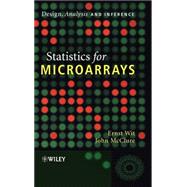
What is included with this book?
Ernst Wit is the author of Statistics for Microarrays: Design, Analysis and Inference, published by Wiley.
John McClure is the author of Statistics for Microarrays: Design, Analysis and Inference, published by Wiley.
| Preface | xi | ||||
| 1 Preliminaries | 1 | (112) | |||
|
1 | (2) | |||
|
2 | (1) | |||
|
3 | (1) | |||
|
3 | (132) | |||
|
4 | (2) | |||
|
6 | (1) | |||
|
7 | (2) | |||
|
9 | (1) | |||
|
10 | (103) | |||
| I Getting Good Data | 113 | (22) | |||
|
15 | (8) | |||
|
15 | (1) | |||
|
16 | (7) | |||
|
17 | (1) | |||
|
17 | (1) | |||
|
18 | (1) | |||
|
19 | (1) | |||
|
19 | (1) | |||
|
19 | (1) | |||
|
20 | (3) | |||
|
23 | (34) | |||
|
24 | (2) | |||
|
26 | (10) | |||
|
27 | (2) | |||
|
29 | (1) | |||
|
30 | (6) | |||
|
36 | (4) | |||
|
37 | (2) | |||
|
39 | (1) | |||
|
40 | (4) | |||
|
41 | (1) | |||
|
42 | (1) | |||
|
42 | (2) | |||
|
44 | (13) | |||
|
44 | (6) | |||
|
50 | (7) | |||
|
57 | (46) | |||
|
57 | (5) | |||
|
58 | (2) | |||
|
60 | (1) | |||
|
61 | (1) | |||
|
62 | (1) | |||
|
62 | (7) | |||
|
63 | (2) | |||
|
65 | (1) | |||
|
65 | (4) | |||
|
69 | (24) | |||
|
70 | (1) | |||
|
71 | (5) | |||
|
76 | (4) | |||
|
80 | (4) | |||
|
84 | (9) | |||
|
93 | (10) | |||
|
93 | (1) | |||
|
94 | (9) | |||
|
103 | (22) | |||
|
104 | (1) | |||
|
104 | (1) | |||
|
105 | (8) | |||
|
105 | (1) | |||
|
106 | (5) | |||
|
111 | (2) | |||
|
113 | (10) | |||
|
114 | (3) | |||
|
117 | (2) | |||
|
119 | (2) | |||
|
121 | (2) | |||
|
123 | (2) | |||
|
125 | (12) | |||
|
125 | (4) | |||
|
125 | (4) | |||
|
129 | (1) | |||
|
129 | (8) | |||
|
129 | (2) | |||
|
131 | (1) | |||
|
132 | (1) | |||
|
133 | (2) | |||
| II Getting Good Answers | 135 | (116) | |||
|
137 | (40) | |||
|
137 | (18) | |||
|
138 | (1) | |||
|
139 | (5) | |||
|
144 | (11) | |||
|
155 | (5) | |||
|
156 | (1) | |||
|
157 | (3) | |||
|
160 | (17) | |||
|
160 | (3) | |||
|
163 | (14) | |||
|
177 | (34) | |||
|
177 | (2) | |||
|
177 | (2) | |||
|
179 | (1) | |||
|
179 | (17) | |||
|
180 | (3) | |||
|
183 | (9) | |||
|
192 | (3) | |||
|
195 | (1) | |||
|
196 | (15) | |||
|
200 | (3) | |||
|
203 | (8) | |||
|
211 | (36) | |||
|
211 | (7) | |||
|
212 | (5) | |||
|
217 | (1) | |||
|
218 | (5) | |||
|
218 | (2) | |||
|
220 | (2) | |||
|
222 | (1) | |||
|
222 | (1) | |||
|
223 | (12) | |||
|
223 | (4) | |||
|
227 | (4) | |||
|
231 | (4) | |||
|
235 | (12) | |||
|
235 | (8) | |||
|
243 | (4) | |||
|
247 | (4) | |||
|
247 | (2) | |||
|
247 | (1) | |||
|
248 | (1) | |||
|
248 | (1) | |||
|
249 | (2) | |||
|
249 | (2) | |||
| Bibliography | 251 | (8) | |||
| Index | 259 |
The New copy of this book will include any supplemental materials advertised. Please check the title of the book to determine if it should include any access cards, study guides, lab manuals, CDs, etc.
The Used, Rental and eBook copies of this book are not guaranteed to include any supplemental materials. Typically, only the book itself is included. This is true even if the title states it includes any access cards, study guides, lab manuals, CDs, etc.